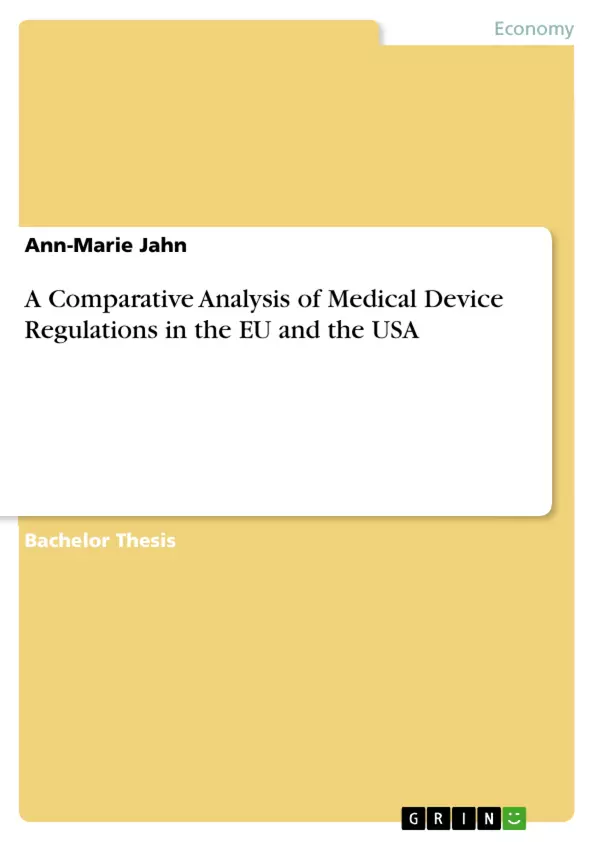Innovations in the medical device industry have improved the health of the world population with the ability to better diagnose, prevent, predict and cure illnesses. The number of medical devices on the market is increasing exponentially, together with the complexity, diversity and technical variation of such products. In light of its impact on patient health, regulation of medical devices is necessary to ensure that safe and effective products enter the marketplace, and that the product’s benefit to the patient population outweighs its potential risks. Although there has been increasing public scrutiny of health care reform, medical devices and their global regulation has been a minor field of health economic studies. This study examines the medical device regulatory systems and its impact on health care economics, exemplarily on the legislative programs of two major markets - the United States (U.S.) and European Union (EU).
Modern medical device technology dates its origin to the early 19th century, but has grown most significantly in the last 50 years (Banta, p. 15). Today, 10,000 different families of medical device types exist with more than 400,000 different individual products on the market (Eucomed 2011). Outstanding developments have included heart-lung machines, artificial joints, as well as radiographic imaging and the means to perform advanced brain surgery. The medical device technology sector is extremely innovative, with seven out of ten major medical innovations in the last 40 years coming from this field (Fuchs, Sox, JR. 2001).
Despite these technological advances, medical devices sometimes fail during use and can actually result in patient harm. The purpose of regulating medical equipment is to minimize the risk of harm to the end user and to prevent potentially unsafe products from entering the marketplace. The main obstacle in developing and implementing effective regulation is the term safety itself, as it can hardly be measured and there is no formula that can be consistently applied. Guidelines have been established that measure product risk, mitigate risks where possible, and then evaluate the residual risks to determine which are acceptable. This means by implication that acceptance of risk is part of the regulation process in order to bring life-saving technologies with unknown long-term effects to the market.
Inhaltsverzeichnis (Table of Contents)
- Introduction
- Research Question
- Plan of Research
- Economics of Health Care
- Principles of Economics
- Regulating Markets
- European Medical Device Regulations
- General Regulatory Framework
- Conformity Assessment Procedure
- Placing Products on the Market
- Case Study - Poly Implant Prothèse
- Medical Device Regulations in the United States
- Analysis of current Regulatory Framework
- Premarketing Requirements
- Device Production and Quality Management
- Case Study - Medtronic Infuse Bone Graft
- Conclusion and Recommendations
- Comparison
- Recommendation
- Critical Acclaim
- Outlook and Forecast
Zielsetzung und Themenschwerpunkte (Objectives and Key Themes)
This study investigates the medical device regulatory systems in the United States and European Union, examining their impact on health care economics. It focuses on the effectiveness of these regulatory programs in balancing safety and innovation, ensuring safe and effective medical devices reach the market while promoting economic growth.
- The economic impact of medical device regulations
- The balance between safety and innovation in medical device regulation
- Comparison of regulatory frameworks in the US and EU
- Case studies of medical device failures and their implications
- Recommendations for improving medical device regulation
Zusammenfassung der Kapitel (Chapter Summaries)
The introduction establishes the research question, highlighting the increasing need for medical device regulation given the growing complexity and diversity of devices. It emphasizes the importance of ensuring safe and effective products reach the market while considering the economic implications of regulation.
Chapter 2 explores the economics of health care, providing a foundational understanding of economic principles relevant to medical device regulation. It discusses concepts like market regulation and how economic models can be applied to the medical device industry.
Chapter 3 delves into the European Medical Device Regulations, providing a comprehensive overview of the regulatory framework. It examines the general regulatory framework, the conformity assessment procedure, and the process of placing products on the market, with a case study on Poly Implant Prothèse to illustrate real-world implications.
Chapter 4 examines medical device regulations in the United States, presenting a detailed analysis of the current regulatory framework, premarketing requirements, and device production and quality management practices. The chapter includes a case study on Medtronic Infuse Bone Graft to explore the impact of regulatory oversight on specific devices.
Schlüsselwörter (Keywords)
This work focuses on the intersection of medical device regulation, health care economics, and patient safety. Key concepts include regulatory frameworks, conformity assessment, premarketing requirements, safety and innovation, market regulation, and case studies of medical device failures. The study examines the impact of regulations on the US and EU markets, highlighting the need for effective regulation to balance public health and economic growth.
- Arbeit zitieren
- Ann-Marie Jahn (Autor:in), 2012, A Comparative Analysis of Medical Device Regulations in the EU and the USA, München, GRIN Verlag, https://www.grin.com/document/197712



